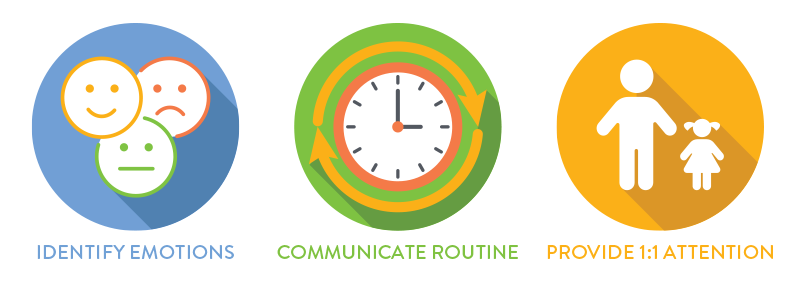
How can I help my child identify and communicate their feelings?
It takes time for toddlers to develop the skill of expressing their emotions, particularly if they are too young to communicate. A toddler brain is still learning to regulate and process the intense emotions they may be feeling at any given time. A great way to help them learn to understand what they are feeling is by naming their emotions. For example, “Your tears tell me that you’re feeling sad.” This coaching will help them learn to identify and express their feelings as they begin to communicate. Understanding how to communicate their feelings is a lifelong skill.
How can I help my child work through a tantrum?
Validate your child’s feelings when they are having a tantrum. This acknowledgment allows your child to feel understood and their intense emotions will resolve faster. For example, “I understand you wanted to play with the blue truck. The blue truck isn’t available right now. It’s okay to feel disappointed.”
Tantrums can be thought of as a cycle. First, your child experiences anger over an event or situation. Stay nearby but allow them to experience this feeling independently. Next, your child will transition to feeling sad. Offer your child a hug if they respond well to physical touch. Finally, your child will calm down. This is the time to discuss the events that occurred and help them learn from the experience.
Are there things I can do to help prevent tantrums and power struggles?
Tantrums and power struggles are a normal part of development. They often happen when a child is seeking independence or when they are learning to communicate and regulate emotions. There are strategies you can use to help decrease temper tantrums.
Transitions: Some children struggle with transitions. It can be difficult for them to abruptly change tasks without warning. Try creating a visual schedule for your child and hang it on the wall. Look at the schedule with them and communicate when transitions are happening. Routines and predictability allow toddlers to feel prepared for what will happen next.
Opportunities for Control: It is normal for toddlers to want independence and choice. Giving them opportunities to choose or have control can minimize power struggles. For example, let your child pick their clothes, choose from two options for breakfast, or pick the next activity to do together.
Individual Attention: Provide your child with special, one-on-one time. Announce and schedule short sessions as many days as possible. Giving your child individualized attention can fill their emotional cup, leading to a decrease in emotional outbursts. Allow your child to make the rules (as long as it’s a safe choice!) and choose what activities to do together. Make sure to avoid distractions like siblings and phones. Spending just 10 minutes of attention focused on your child can make a positive impact on their behavior. More information can is available from Seattle Children’s on Child-Directed Play.
Keep Reading
View All Posts
Summer Safety Tips
Summer is a season of fun and adventure, but it also brings unique safety challenges for kids. Dr. Brianna Label offers practical tips to help families stay safe all season long.

Nexplanon: A Guide for Teens and Parents
Nexplanon is a form of Long-Acting Reversible Contraception (LARC) offered at Allegro for birth control or to help manage painful periods. Learn how it works, its benefits, and potential side effects to help you and your teen make informed decisions together.


